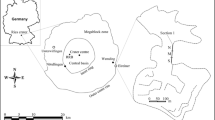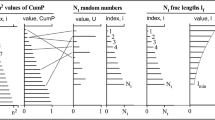Summary
Thirteen natural rock profiles (Barton and Choubey, 1977) are analyzed for their fractal properties. Most of the profiles were found to approximate fractal curves but some also showed features of specific wavelengths and amplitudes superimposed on fractal characteristics. The profiles showed fractal dimensions from 1.1 to 1.5 covering a range of selfsimilar and self-affine curves. The analysis results suggest a negative correlation between fractal dimension,D, and amplitude,A. Joint roughness coefficients (JRC) show a positive correlation with amplitude,A, and a negative correlation with fractal dimension,D. A numerical model of fracture closure is used to investigate the effects of different profile characteristics (D, A and sample size) on the nature of dilation and contact area, using the natural profiles and synthetic fractional Brownian motion profiles. Smooth profiles (low JRC, highD, lowA) display many small contact regions whereas rough fractures (high JRC, lowD, highA) display few large contact areas. The agreement with published experimental data supports the suggested correlations between JRC and the fractal parameters,A andD. It is suggested that observed scale effects in JRC and joint dilation can be explained by small differential strain discontinuities across fractures, which originate at the time of fracture formation.
Similar content being viewed by others

References
Bandis, S., Lumsden, A. C., Barton, N. R. (1981): Experimental studies of scale effects on the shear behaviour of rock joints. Int. J. Rock Mech. Min. Sci. Geomech. Abstr. 18, 1–21.
Barton, N., Bandis, S., Bakhtar, K. (1985): Strength, deformation and conductivity coupling of rock joints. Int. J. Rock Mech. Min. Sci. Geomech. Abstr. 22, 121–140.
Barton, N., Choubey, V. (1977): The shear strength of rock joints in theory and practice. Rock Mechanics 10, 1–54.
Brown, S. R. (1987): Fluid flow through rock joints: the effect of surface roughness. J. Geophys. Res. B 92, 1337–1347.
Brown, S. R., Scholz, C. H. (1985): Broad bandwidth study of the topography of natural rock surfaces. J. Geophys. Res. B 90, 12575–12582.
Carr, J. R., Warriner, J. B. (1989): Relationship between the fractal dimension and joint roughness coefficient. Bull. Assoc. Eng. Geol. 24, 253–263.
Carr, J. R. (1989): Fractal characterization of joint roughness in welded tuff at Yucca Mountain, Nevada. In: Proc., 30th U.S. Symp. Rock Mech., Morgantown, West Virginia, 193–200.
Engelder, T., Scholz, T. C. (1981): Fluid flow along very smooth joints at effective pressures up to 200 MPa. In: Mechanical behaviour of crustal rocks. Am. Geophys. Union Monogr. 24, 147–152.
Feder, J. (1988): Fractals. Plenum, New York.
Huang, S. L., Oelfke, S. M., Speck, R. C. (1992): Applicability of fractal characterization and modelling to rock joint profiles. Int. J. Rock Mech. Min. Sci. Geomech. Abstr. 29, 89–98.
Iwano, M. (1990): Probabilistic modelling of a single fracture. M.Sc. thesis, MIT, Cambridge, USA.
Leary, P. (1991): Deep bore hole log evidence for fractal distribution of fractures in crystalline rock. Geophys. J. Int. 107, 615–627.
Lee, Y.-H., Carr, J. R., Barr, D. J., Haas, C. J. (1990): The fractal dimension as a measure of the roughness of rock discontinuity profiles. Int. J. Rock Mech. Min. Sci. Geomech. Abstr. 27, 453–464.
Maerz, N.H., Franklin, J. A. (1990): Roughness scale effects and fractal dimension. In: Proc., First Int. ISRM Workshop on Scale Effects in Rock Masses, Loen, Norway, 121–126.
Mandelbrot, B. B. (1982): The fractal geometry of nature. Freeman, New York.
Mandelbrot, B. B. (1985): Self-affine fractals and fractal dimension. Physica Scripta 32, 257–260.
Mandelbrot, B. B., van Ness, J. W. (1968): Fractional Brownian motions, fractional noises and applications. SIAM Rev. 10, 422–437.
Mandelbrot, B. B., Passoja, D. E., Paullay, A. J. (1984): Fractal character of fracture surfaces of metals. Nature 308, 721–722.
Muralha, J., Charrua-Graça, J. G. (1990): An experience on the application of fractal theory to basic shear strength studies. In: Proc., Int. ISRM Symp. Rock Joints, Loen, Norway, 667–672.
Muraoka, H., Kamata, H. (1983): Displacement distribution along minor faults. J. Struct. Geol. 5, 483–495.
Nolte, D. D., Pyrak-Nolte, L. J., Cook, N. G. W. (1989): The fractal geometry of flow paths in natural fractures in rock and the approach to percolation. PAGEOPH 131, 111–138.
Poon, C. Y., Sayles, R. S., Jones, T. A. (1992): Surface measurement and fractal characterization of naturally fractured rocks. J. Phys. D: Applied Phys. 25, 1269–1275.
Power, W. L., Tullis, T. (1991): Euclidean and fractal models for the description of rock surface roughness. J. Geophys. Res. B 96, 415–424.
Raven, K. G., Gale, J. E. (1985): Water flow in a natural rock fracture as a function of stress and sample size. Int. J. Rock Mech. Min. Sci. Geomech. Abstr. 22, 251–261.
Saupe, D. (1988): Algorithms for random fractals. In: Peitgen, H., Saupe, D. (eds.) The science of fractal images, Springer, New York Berlin Heidelberg, 71–133.
Sayles, R. S., Thomas, T. R. (1977): The spatial representation of surface roughness by means of the structure function: a practical alternative to correlation. Wear 42:263–276.
Tsang, Y. W., Tsang, C. F. (1989): Flow channeling in a single fracture as a two-dimensional strongly heterogeneous permeable medium. Water Resour. Res. 25, 2076–2080.
Tsang, Y. W., Witherspoon, P. A. (1983): The dependence of fracture mechanical and fluid flow properties on fracture roughness and sample size. J. Geophys. Res. B 88, 2359–2366.
Vickers, B. C., Neuman, S. P., Sully, M. J., Evans, D. D. (1992): Reconstruction and geostatist analysis of multiscale fracture apertures in a large block of welded tuff. Geophys. Res. Let. 19, 1029–1032.
Voss, R. (1988): Fractals in nature. In: Peitgen, H., Saupe D. (eds.) The science of fractal images, Springer, New York Berlin Heidelberg, 21–69.
Wakabayashi, N., Fukushige, I. (in press): Experimental study on the relation between fractal dimension and shear strength. In: Proc., ISRM Int. Conference Fractured and Jointed Rock Masses, Lake Tahoe, California.
Watterson, J. (1986): Fault dimensions, displacements and growth. PAGEOPH 124, 365–373.
Xie, H., Pariseau, W. G. (in press): Fractal estimation of joint roughness coefficients. In: Proc., ISRM Int. Conference Fractured and Jointed Rock Masses, Lake Tahoe, California.
Author information
Authors and Affiliations
Rights and permissions
About this article
Cite this article
Odling, N.E. Natural fracture profiles, fractal dimension and joint roughness coefficients. Rock Mech Rock Engng 27, 135–153 (1994). https://doi.org/10.1007/BF01020307
Issue Date:
DOI: https://doi.org/10.1007/BF01020307



